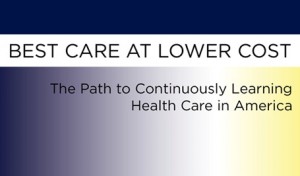Pathologists and clinical laboratory directors can learn from other industries about how to better achieve quality and cost goals
Why are pathology groups, clinical laboratories, and the majority of healthcare providers so slow to borrow innovative approaches from commercial businesses that measurably improve patient service, quality, and satisfaction? No less an authority than, the Institute of Medicine (IOM) has taken the entire healthcare system to task for being so slow to adopt proven innovations that are being rapidly taken up by non-healthcare industries.
These findings were published in a report recently issued by the Institute of Medicine. Authors of the report found that when it comes to quality, outcomes, cost, and equity, healthcare falls short when compared to other industries.
Lessons for Clinical Labs in the IOM’s Latest Report
“The IOM notes that the past half century has had dramatic biomedical advances,” wrote Canadian star health reporter, André Picard, in a commentary published in The Globe and Mail. “The paradox is that comparable progress has not come on the management side [of healthcare].”
According to the IOM report, Americans spend $2.6 trillion a year for healthcare. Roughly one-third—about $750 billion—of that $2.6 trillion is attributable to waste. Here’s how the wasted dollars break down:
- unnecessary care—$210 billion;
- excessive administration—$190 billion;
- inefficient delivery of care—$130 billion;
- inflated prices—$105 billion;
- fraud—$75 billion; and
- prevention failures—$55 billion.
Healthcare Management Falls Short Compared to Other Industries
“The full extent of these shortcomings is visible when considering how other industries routinely operate compared with many aspects of healthcare,” stated the IOM in its September 6 Report Brief. “[T]he healthcare system could learn from these industries how to better meet specific needs, expand choices, and shave costs.”

Why are healthcare providers, including clinical laboratories and pathology groups, so slow to recognize and adopt the same service innovations developed by non-healthcare industries? A recently issued report by the Institute of Medicine (IOM) looks at this problem and makes recommendations. Titled “Best Care at Lower Cost,” the report cites examples of how clinical laboratory test results are frequently unavailable at the time a patient visits his/her physician. (Graphic by the Institute of Medicine.)
In his commentary, Picard pointed out specific analogies the IOM used to drive home how healthcare management has lagged behind other industries in effectiveness. Dark Daily observes that there is simple wisdom in the IOM’s list:
- If banking were like healthcare, automated transactions would take days rather than seconds because of unavailable or misplaced records.
- If home building were like healthcare, carpenters, electricians and plumbers would work from different blueprints, with very little coordination.
- If shopping were like healthcare, prices would not be posted and would vary widely within the same store.
- If automobile manufacturing were like healthcare, there would be no warranties for cars and, therefore, no incentive to monitor and improve performance and product quality.
- If airline travel were like healthcare, each pilot would be free to design his or her own pre-flight safety check, or not perform one.
Know-how and Technology Is Available for Medical Laboratories
Effective transformation of U.S. healthcare systems is not a question of lack of information or tools. “[W]e have the know-how and technology to make substantial improvement on costs and quality,” observed IOM committee chair Mark D. Smith, M.D., M.B.A., President and CEO, California HealthCare Foundation, Oakland, in the IOM news release.
However, the change won’t come easily, according to Picard. “Doing what is best for patients, the health system, and the taxpayer is not going to be easy because many vested interests profit handsomely from the status quo,” he wrote in the Globe and Mail.
“[I]t’s time to get all hands on deck,” Smith declared in the news release.
Canada Could Use a Healthcare Reality Check, Says Journalist
Patient experience and patient satisfaction with healthcare services are an issue in Canada, as in the United States. “Canada, like the United States, has few checks and balances,” Picard wrote. “[Both countries tend] to reward volume rather than innovation and results. That’s why many costly inefficiencies are ingrained.”
Referring to the IOM report, Picard observed, “Canada has had no similar analysis. We could certainly use a reality check.”
Forward looking pathologists and clinical laboratory managers may want to review the IOM report and use its analysis to assess cultural barriers to change that exist within their own lab organizations. The goal should be to consider whether there are principles and practices from other industries with potential for helping their medical laboratories to more effectively deliver high-value diagnostic testing services to referring physicians and their patients.
—Pamela Scherer McLeod
Related Information:
We all pay when healthcare focuses on volume not quality.
Best Care at Lower Cost: The Path to Continuously Learning Health Care in America
Transformation of Health System Needed to Improve Care and Reduce Costs




They considered China the core of the empire, and intended to keep it. Roosevelt explicitly wanted them out.